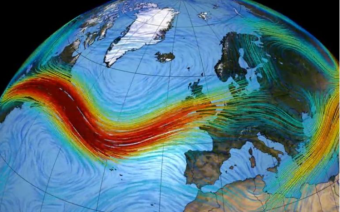New research led by the National Oceanography Centre (NOC) and the Maynooth University ICARUS Climate Research Centre in Ireland shows that the average winter northern hemisphere jet stream position over the North Atlantic and Eurasia has moved northwards by up to 330km.
The research has also revealed that the mean winter jet speed has increased by 8% to 132mph, during the 141-year period from 1871–2011.
Jet streams are fast bands of air which flow around the globe around ten thousand metres above Earth’s surface. They have a significant influence on storm activity and temperature patterns across the northern hemisphere which can impact the weather through strong winds and flooding events. This is the longest regional study of the northern hemisphere jet stream and the trends observed are potential indicators of climate change.
The study, published in Climate Dynamics, provides a comparison of the Northern Hemisphere jet stream across oceans and continents and finds that jet stream trends vary on a regional and seasonal basis. Between 1871 and 2011 the average winter movement in jet stream latitude over the North Atlantic was from 44° to 47° north with an increase of 10mph in speed to 132mph, but no increases were observed over the North Pacific.
The study was led by Dr Samantha Hallam, from the Maynooth University ICARUS Climate Research Centre and the NOC, said: “Significant increases in winter jet latitude and speed are observed over the North Atlantic and Eurasia. These changes are consistent with the decreasing temperature and increasing pressure gradients observed between the equator and the Arctic over the period.”
“Over the North Pacific, no increase in jet latitude or speed are observed, however, changes in the North Pacific Sea surface temperatures explains over 50% of the variability in jet latitude.”
Dr Joel Hirschi, co-author from the NOC commented “The results highlight that northern hemisphere jet variability and trends differ on a regional basis across the North Atlantic, North Pacific, Eurasia and North America. This is important for making climate predictions and developing plans.”
These findings are the result of a statistical analysis of the 250mb jet stream using the Twentieth Century Reanalysis dataset.
The research was supported by the Marine Institute and funded by the Irish Government under the JPI Climate and JPI Ocean joint call and the Natural Environmental Research Council and involved collaboration between The Irish Climate Analysis Research Units (ICARUS) at Maynooth University in Ireland, University of Southampton, UK and National Oceanography Centre, UK.

